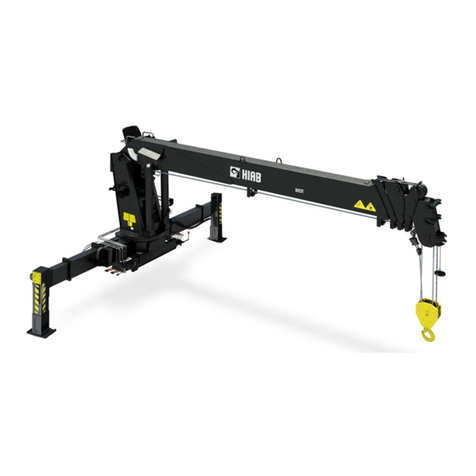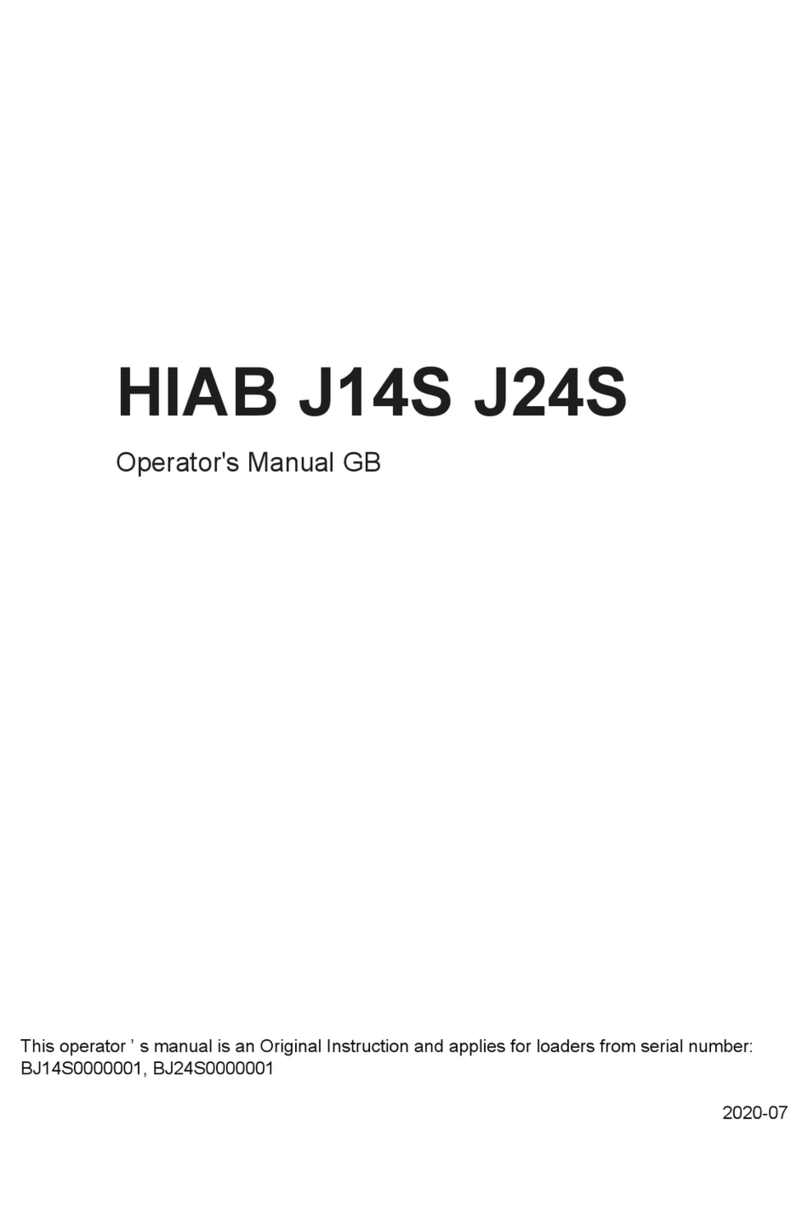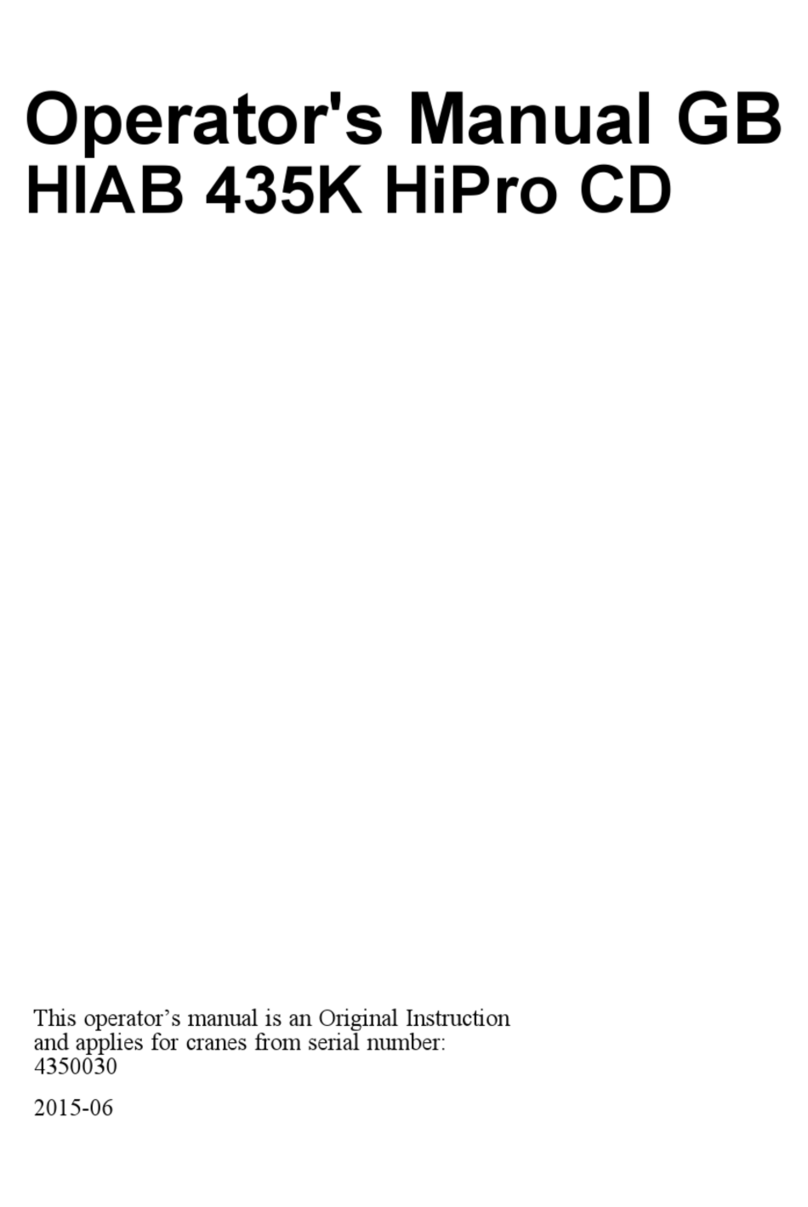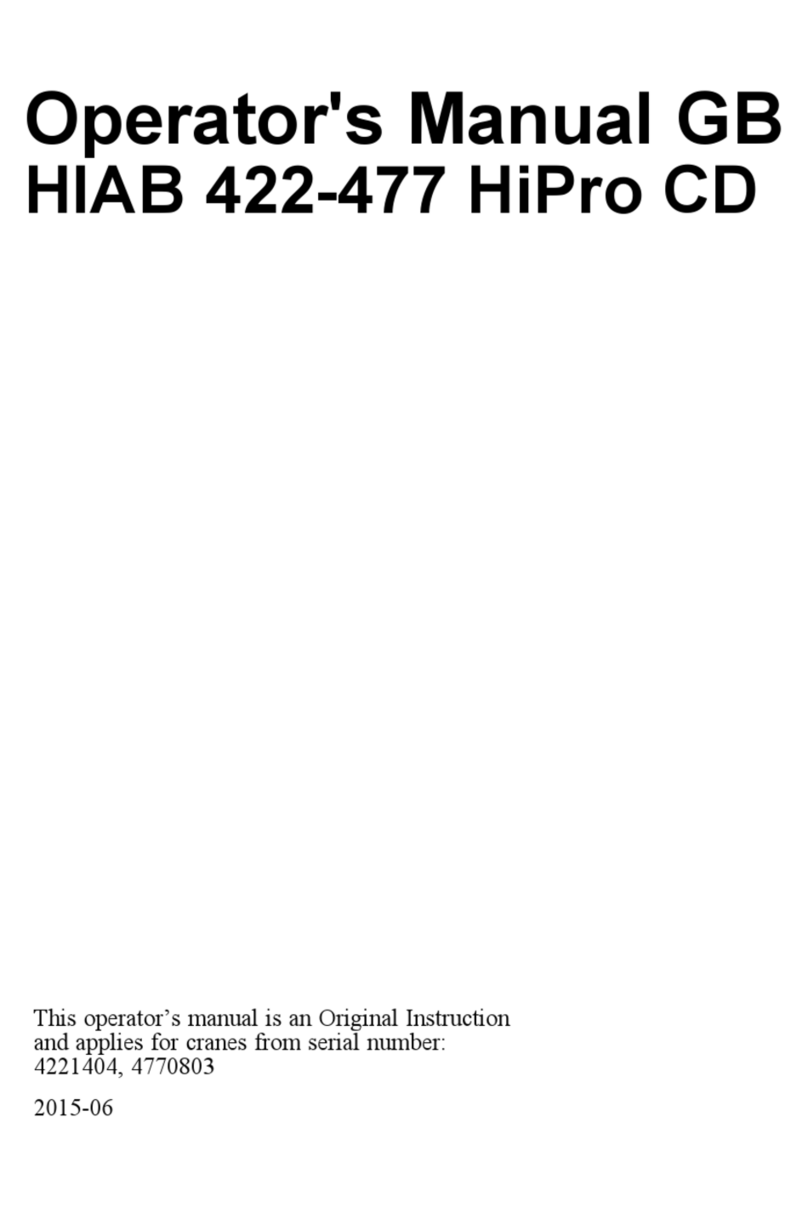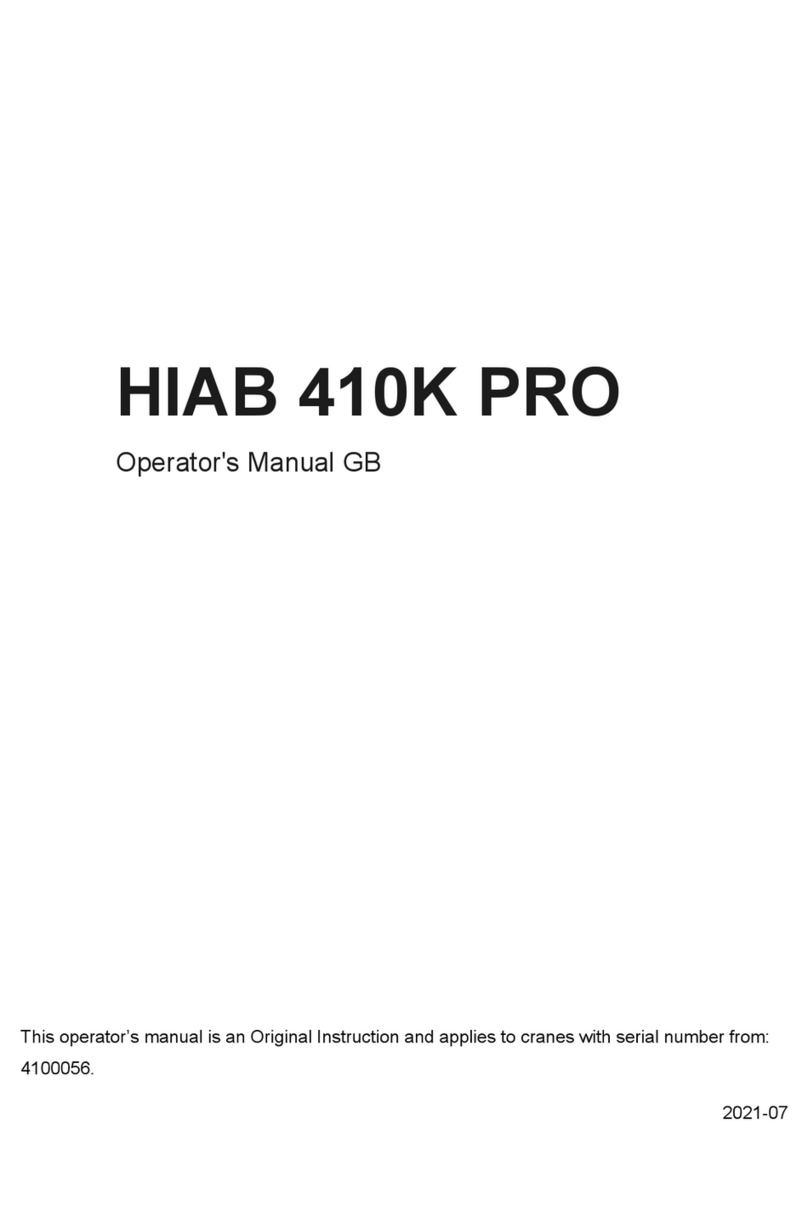HIAB 335K HiPro CD CE User manual

Operator's Manual GB
HIAB 335K Pro-HiPro CD
This manual applies to crane 3350686 and from serial number: 3350690
2012-06

Congratulations with your new crane!
You are now the owner of a quality product from
Cargotec, built to the highest standards of safety and
quality.
The aim of this manual is to help you handle your crane
safely and with full satisfaction.
Please read the complete manual. It provides detailed
information about the crane, safety system and the
practical management and maintenance of the crane.
We advise you to read it carefully and familiarize yourself
with your crane before you start to use it.
2Operator's Manual GB

Table of Contents
1. Knowledge required............................................................................... 6
1.1 This Operator's Manual is intended for operators of this HIAB crane. .... 6
1.2 Indications in the Operator’s Manual ................................................ 7
2. Structure and parts of the HIAB crane..................................................... 10
2.1 Main groups ............................................................................... 10
2.2 Crane base with column and slewing system .................................... 10
2.3 Boom system.............................................................................. 10
2.4 Stabiliser system.......................................................................... 12
2.5 Operating system - hydraulic components........................................ 13
2.6 LHV Load holding valves............................................................. 13
2.7 Description of Hiab 335K Pro/HiPro-CD......................................... 14
3. Safety precautions and warnings............................................................. 15
3.1 Operating conditions .................................................................... 15
3.2 Definition of a HIAB loader crane.................................................. 16
3.2.1 Noise declaration................................................................. 17
3.2.2 Warning signs..................................................................... 18
3.2.3 Maximum load.................................................................... 18
3.2.4 Maximum load moment........................................................ 21
3.3 Signals when using a crane............................................................ 24
3.4 Wind speeds ............................................................................... 28
3.5 Use of the crane .......................................................................... 29
3.6 Use of lifting equipment ............................................................... 36
3.7 Use of dismountable cranes........................................................... 36
4. The Safety system................................................................................ 38
4.1 Safety System SPACE 3000/5000 and Remote Control...................... 38
4.2 How the safety system works......................................................... 38
4.3 Components of SPACE Safety System............................................ 40
4.4 Operating components.................................................................. 42
4.5 Main control valve....................................................................... 42
4.6 Stabiliser control valve ................................................................. 44
4.7 Extra stabiliser leg [option] ........................................................... 45
4.8 Selector valve [option].................................................................. 45
Operator's Manual GB 3

Table of Contents
4.9 Cranes with high seat [option] ....................................................... 46
4.10 OPS Operator Protection System [option] ........................................ 47
4.11 User panel SPACE 3000............................................................... 47
4.11.1 Indicator lights on user panel SPACE 3000.............................. 48
4.12 User panel SPACE 5000............................................................... 49
4.12.1 Indicator lights on user panel SPACE 5000.............................. 50
4.13 CombiDrive2 .............................................................................. 52
4.14 Main menus CombiDrive2 ............................................................ 55
4.15 Battery charger CD2 .................................................................... 62
4.16 Functions ................................................................................... 63
5. Starting crane operation........................................................................ 66
5.1 Starting operations....................................................................... 66
5.2 Extend stabiliser extensions and set stabiliser legs............................. 70
5.3 Operate the crane out of parked position.......................................... 72
6. During operation ................................................................................. 74
6.1 OLP (Overload protection)............................................................ 74
7. Ending crane operation......................................................................... 79
7.1 Operate the crane to parking position.............................................. 79
7.4 Placing the stabiliser extensions and legs in transport position............. 80
7.5 Switching off the safety system...................................................... 81
7.6 Emergency operation Valve-V91.................................................... 81
7.7 TWI Transport warning interface [option]........................................ 82
8. Maintenance and Service ...................................................................... 84
8.1 Service ...................................................................................... 84
8.2 Warranty.................................................................................... 85
8.3 Follow the maintenance instructions! .............................................. 86
8.3.1 Daily inspection .................................................................. 87
8.3.2 Monthly inspection and maintenance....................................... 88
8.3.3 Annual maintenance............................................................. 90
8.4 Lubrication................................................................................. 90
8.4.1 Lubrication schedule ............................................................ 91
8.4.2 Lubrication of slide pads in boom system ................................ 91
4Operator's Manual GB

Table of Contents
8.4.3 Lubrication of the upper column bearing and three-point bridge... 92
8.5 Hydraulics.................................................................................. 93
8.5.1 Slewing housing: checking the oil level/oil change.................... 93
8.5.2 Replacing the return oil filter................................................. 94
8.5.3 Replacing the cartridge in the pressure reduction filter ............... 94
8.5.4 High pressure filter [option] .................................................. 95
8.5.5 Checking the oil tank level.................................................... 95
8.5.6 Changing the hydraulic oil .................................................... 95
8.5.7 Bleeding air from the hydraulic system.................................... 97
8.6 Troubleshooting .......................................................................... 98
8.6.1 Main fuses.......................................................................... 98
8.6.2 Faults in the HiPro crane ...................................................... 98
9. Decommissioning............................................................................... 102
9.1 Decommissioning a crane............................................................ 102
10. Technical Data .................................................................................. 104
10.1 Documentation .......................................................................... 104
Operator's Manual GB 5

Knowledge required
1
1.1 This Operator's Manual is
intended for operators of this
HIAB crane.
This manual describes:
• Operation
• Safety precautions and warnings
• The crane safety system
• Maintenance and troubleshooting
Enclosed to this manual the Installer will
provide:
• Technical Data for your crane
• Technical Data and manuals for add on
equipment if fitted
Study these instructions carefully
DANGER
If you do not study the complete Operator’s
Manual for your crane carefully, it could lead
to fatal accidents or serious damage.
Therefore you should:
• Study the entire Operator’s Manual carefully.
• Study the operating manuals for other add-on
equipment, if fitted.
• Use the crane only after having done so.
• Follow the directions for use, operation and
maintenance of the crane and add on equip-
ment exactly.
• Store the Operator’s Manual for your type of
crane, the Technical Data and manuals from
the Installer, together with this Operator's
manual.
6Operator's Manual GB

Knowledge required 1.2
NOTE
The manual is written in English and translated to
the local language by the manufacturer. The
manufacturer reserves the right to change specifi-
cations, equipment, operating instructions and
maintenance instructions without prior notice.
1.2 Indications in the Operator’s
Manual
What must you do and not do?
The following indications are used in the Opera-
tor’s Manual:
DANGER
Danger to life for yourself or to bystanders.
Follow the instructions carefully!
WARNING
Danger of injury to yourself or to bystanders,
or danger of serious damage to the crane or
other objects.
Follow the instructions carefully.
CAUTION
Hazard for the crane or crane components.
Follow the instructions carefully.
Important:
If actions are numbered
1. Do this
2. Do that
3. ......
4. .....
5. .....
Operator's Manual GB 7

1
Knowledge required
1.2
you should carry them out in numerical order!
NOTE
Extra information that can prevent problems.
TIP
Tip to make the work easier to carry out.
Symbol for reference to a component in an
illustration.
①Refers to a component in an illustration.
[option]: Indication for parts that are not-standard
for the crane, but are an option.
DANGER
Only persons with the requisite knowledge and
experience with cranes may use the crane.
Never operate the crane when you are sick,
tired, under the influence of medicines, alcohol
or other drugs.
• Take the delivery instructions from your
HIAB Service workshop, or receive instruc-
tion from an experienced person from your
own company. Only then should you operate
your crane.
• Ensure that you comply with the statutory
requirements of the country in which you use
the crane (for example, certificate, obligatory
safety-helmet).
8Operator's Manual GB

Knowledge required 1.2
DANGER
• Carry out yourself only the service and
maintenance work you have the requisite
knowledge and experience of.
• All other maintenance work may only be
carried out by a HIAB service workshop.
• Ensure that every defect is rectified imme-
diately, according to the instructions.
• Follow the instructions exactly!
• All other work to rectify faults must be
performed by personnel in a HIAB service
workshop!
WARNING
• Never clean the electronic system, plastic
components, signs or bearings with a high-
pressure jet cleaner. It could cause damage.
• Never expose the electronic system to high
electrical voltages. This could damage the
safety system.
• Never immerse the controller in water or
other liquid. This will make the controller
unusable.
If your crane is equipped with add-on lifting
equipment (hoist, rotator, etc.):
• The operation of the crane with add-on
lifting equipment can differ from the oper-
ation as described in this manual.
• You should therefore study the Operating
Manual for the add-on equipment careful-
ly, before you use the crane.
• Take particular note when placing the
crane in to or out of transport position.
Operator's Manual GB 9

32
1
Structure and parts of the HIAB crane
2
2.1 Main groups
The HIAB crane consists of the following main
groups:
• Crane base with column and slewing system
• Boom system
• Stabiliser system
• Operating system
2.2 Crane base with column and
slewing system
The crane base, column and the slewing sys-
tem consist of the following components:
• Crane base
with stabiliser beam, column bearings and
three-point bridge.
• Column
this fitted to the crane base and turns in an
upper and a lower bearing.
• Slewing system
2.3 Boom system
The boom system consists of the following
components:
• 1st boom ①
• 2nd boom ②
• Hydraulic extensions ③
The extensions are operated by hydraulic
cylinders placed inside the extensions.
10 Operator's Manual GB

Structure and parts of the HIAB crane 2.3
•Add-on lifting accessories [option]
Add-on lifting accessories are placed between the
boom tip and the load (e.g. pallet fork, grapple,
rotator).
Separate lifting accessories [option]
Separate lifting accessories, help to make or use a
slinging device: eye-hooks, shackles, eye-bolts
etc.
Operator's Manual GB 11

Structure and parts of the HIAB crane
2.4
2.4 Stabiliser system
Every HIAB crane is equiped with two stabiliser
extensions and two stabiliser legs. Auxiliary
stabiliser systems may be needed for heavy
cranes.
• Stabiliser beam ①. The stabiliser beam is a
part of the crane base.
• Stabiliser extensions ②. The stabiliser exten-
sions are hydraulically slid out from the
stabiliser beam.
• Stabiliser legs ③. Place the stabiliser legs on
firm levelled ground to support the crane.
• Stabiliser locking device ④.
• Support plates ⑤. The support plates are used
under the stabiliser legs for additional sup-
port.
12 Operator's Manual GB

Structure and parts of the HIAB crane 2.5
2.5 Operating system - hydraulic
components
The operating system consists of the following
hydraulic components:
• oil tank
• hydraulic pump
• oil cooler [option on some cranes]
• main control valve
• stabiliser control valve [option on some
cranes]
• hydraulic hoses and lines
• actuators:
first boom cylinder
second boom cylinder
extension cylinder/s
slewing cylinders / motor reducers
• return filter
• pressure filter [option]
2.6 LHV Load holding valves
All cylinders are equipped with load-holding
valves as a safety device. After a crane move-
ment they hold the crane in position, also in the
unlikely event of a burst hose.
If there is a leak or a component fractures, such
as a pipe, hose or a coupling, the load-holding
valves will stop the booms from collapsing down,
even when the hydraulic system is switched off,
and you operate a particular crane function.
To operate a hydraulic cylinder equiped with a
load holding valve, an opening pressure is re-
quired.
Operator's Manual GB 13

Structure and parts of the HIAB crane
2.7
2.7 Description of Hiab 335K
Pro/HiPro-CD
The HIAB 335K are compact, fully hydraulically
operated goods cranes.
Lifting capacity:
• HIAB 335K = 26.6 to 28.9 tonne metres (192
470' 6" ft-lbs to 208 672' 6" ft-lbs)
The cranes are supplied in a version:
• HIAB 335K-4 reach: 17.3 metres (56' 9" ft)
The main control valve V91 and the SPACE
3000 safety system are standard equipment on the
HIAB 335K Pro.
The main control valve V91, CombiDrive2 and
the SPACE 5000 safety system are standard
equipment on the HIAB 335K HiPro CD.
The crane type and the manufacturer are marked
on the serial number plate.
NOTE
The exact technical information for your crane is
shown in the Technical Data.
14 Operator's Manual GB

Safety precautions and warnings 3
3.1 Operating conditions
You may only use the crane under the following
conditions:
• In the open air, or in spaces with sufficient
ventilation.
• With a mean wind velocity less than 13.3
m/sec (approx. 29.7 mph). See the wind
speed table.
DANGER
• If you use the crane in a confined space
you could suffocate from the exhaust gases
from the vehicle.
• Never use the crane in a high wind or
storm. When the mean wind velocity ex-
ceeds 13.3 m/sec (approx. 29.7 mph) the
crane will behave unpredictably. Never use
the crane during a thunderstorm.
•Never use the crane at temperatures below
-40° C (-40 °F), as the steel's properties
deteriorate below this temperature.
WARNING
• At temperatures below 0 °C (32 °F):
Do not touch the operating levers during
the first few minutes.
• When starting in cold weather, the wear on
the hydraulic system is greater than at
normal working temperatures.
To minimise wear, the crane should be started as
follows:
• Engage the power take-off at low rpm.
• Allow the system to idle for a few minutes.
• Fixed pump:
Operate the stabiliser leg up for one minute in
order to warm up the oil.
• Variable pump:
Operator's Manual GB 15

Safety precautions and warnings
3.2
Operate stabiliser legs up and down for one
minute, in order to warm up the oil.
3.2 Definition of a HIAB loader
crane
Usage of the crane
The HIAB loader crane is used to lift and move
loads in the working area permitted by the load
plate and the load diagram. The cranes are
normally mounted on a vehicle but they can also
be mounted on a fixed base plate. The crane can
be equipped with a number of accessories.
Loader cranes are designed for loading and
unloading the vehicle, as well as for other duties
as specified:
Permitted duties:
• Loading and unloading cargo from/to a vehi-
cle
• Lifting of loads from the ground/vehicle to a
higher place
• Installation work (beams, concrete plates,
windows...) in building constructions
• Lifting construction material (wall boards,
bricks, blocks…) on a pallet fork to a build-
ing, taking the material from the vehicle on
which the crane is mounted, from another
vehicle or from the ground
• Hoisting, e.g. beams, concrete plates and any
other material and equipment used in building
construction
• With a bucket, moving filling material at a
construction site
• Handling large loads (containers, boats, ma-
chinery, vehicles…)
• Collection of waste and recycling material
(glass, paper, cardboard, plastic…)
• Installation of informative posts, road signs,
notice boards, traffic lights, street lights…
16 Operator's Manual GB

Safety precautions and warnings 3.2.1
Forbidden duties:
• Crane mounted onboard ships or floating
structures, only permitted in cases authorized
by HIAB
• Continuous use as a production crane in
assembly lines, foundries…, except for cranes
prepared for that purpose
• Handle loads, work with submerge boom
system or accessories, in strong currents such
as rivers
• Loading cargo that is partially loaded or
fastened by other means, without making sure
the capacity of the crane is enough for the
entire load
• Any duty which implies:
• Pressure against the ground, unless the
crane is specifically prepared for this
• Push/pull with the boom system against
any type of obstacle (wall, ground…)
3.2.1 Noise declaration
The following values for emitted noise may be
taken as general and conservative values for
ordinary installations of loader cranes on normal
diesel engine powered trucks. Declared dual-
number noise emission values in accordance with
ISO 4871:
• Emitted A-weighted sound power level for
basic loader cranes in accordance with ISO
3744: LwA = 103 dB (Uncertainty: KwA = 2
dB)
• Emitted A-weighted sound power level for
loader cranes with hoist in accordance with
ISO 3744: LwA = 107 dB (Uncertainty: KwA
= 2 dB)
• A-weighted sound pressure level at loader
crane control stations in accordance with ISO
11201: LpA = 95 dB (Uncertainty: KpA = 4
dB)
Operator's Manual GB 17

XS
XS
TYPE
SERIALNO
MANUF.YEAR
HIABCRANES S.L.
P.Malpica,E,86
ZARAGOZA-SPAIN
LOADERCRANE
Safety precautions and warnings
3.2.2
Particular installations can be quieter, in which
case a post installation noise measurement in
accordance with clause 6.3 of EN 12999:2011
may be used to prove this.
3.2.2 Warning signs
3.2.3 Maximum load
Lifting capacity
Your crane has a certain lifting capacity, ex-
pressed in kNm or tm. This lifting capacity is
also known as the load moment. The lifting
capacity is: the payload at hook multiplied by the
outreach in metres that the crane can operate at
different positions. The lifting capacity of your
crane determines the maximum load your crane
may lift within its working zone. However take
careful note; the greater the operating radius of
the crane, the lower the lifting capacity will be
because of the weight of the boom system itself.
The load plate and the load diagram on your
crane show the maximum loads you may lift in
the operating reach of your crane.
18 Operator's Manual GB

Safety precautions and warnings 3.2.3
DANGER
• Overloading could result in damage to the
crane or in the worst case, personal injury
or death.
• Never increase a hanging load, since that
may cause a load holding valve to open
and/or the vehicle to turn over.
• Never use the crane with the OLP system
switched off.
! NOTE
The extra weight of the lifting accessories has to
be added to the load. Thus, with lifting access-
ories the load you can lift is less heavy
Load plate
You will find the load plate next to the control
valve. On the plate is the maximum weight that
you may lift at a given reach, with the 1st boom
in the optimum position. In chapter Technical
Data in this manual you will find these values for
your crane.
Optimum position
The weight that your crane can lift will be
determined by:
• Stabilty test of your crane on vehicle [if VSL
as option]
• Stabiliser extensions positioned and legs
pressed to ground.
• The reach at which you are working and the
optimum position of the boom.
• The optimal position for your crane is on the
load plate.
DANGER
Never exceed the maximum weight on the
load plate.
Operator's Manual GB 19

Safety precautions and warnings
3.2.3
Load diagram
The load diagrams are placed on the column and
show the maximum loads your crane may lift in
the entire working zone. The load diagram draw-
ing will also be found in the enclosed Technical
Data.
The white area is the working zone of the
crane.
The load curves show the maximum load that
may be lifted at a given reach and height. For a
given maximum load, the possible working zone
is to the left of the load curve. The lifting
capacity for some cranes is limited in the high
lifting area.
WARNING
Care must be taken when handling loads in the
high lifting area, so the load/tool does not
come into contact with the boom system.
WARNING
Never operate the hydraulic extensions against
a solid objet when the first boom is completely
lifted. Do not try to push or compress loads
when the first boom is fully lifted, as this
could cause damage to the first boom cylinder.
20 Operator's Manual GB
Other manuals for 335K HiPro CD CE
1
Table of contents
Other HIAB Construction Equipment manuals

HIAB
HIAB X-HiPro 358-408-418 X4 User manual

HIAB
HIAB 335K HiPro CD CE User manual
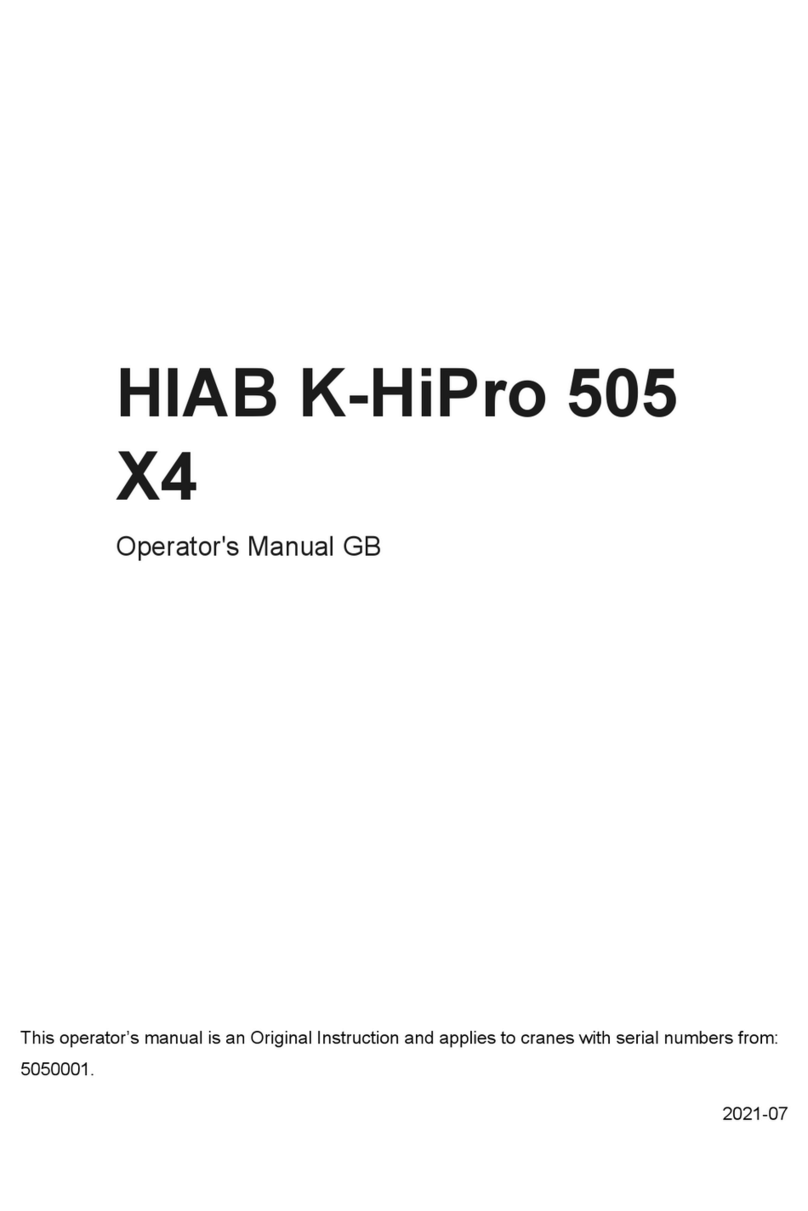
HIAB
HIAB K-HiPro 505 X4 User manual
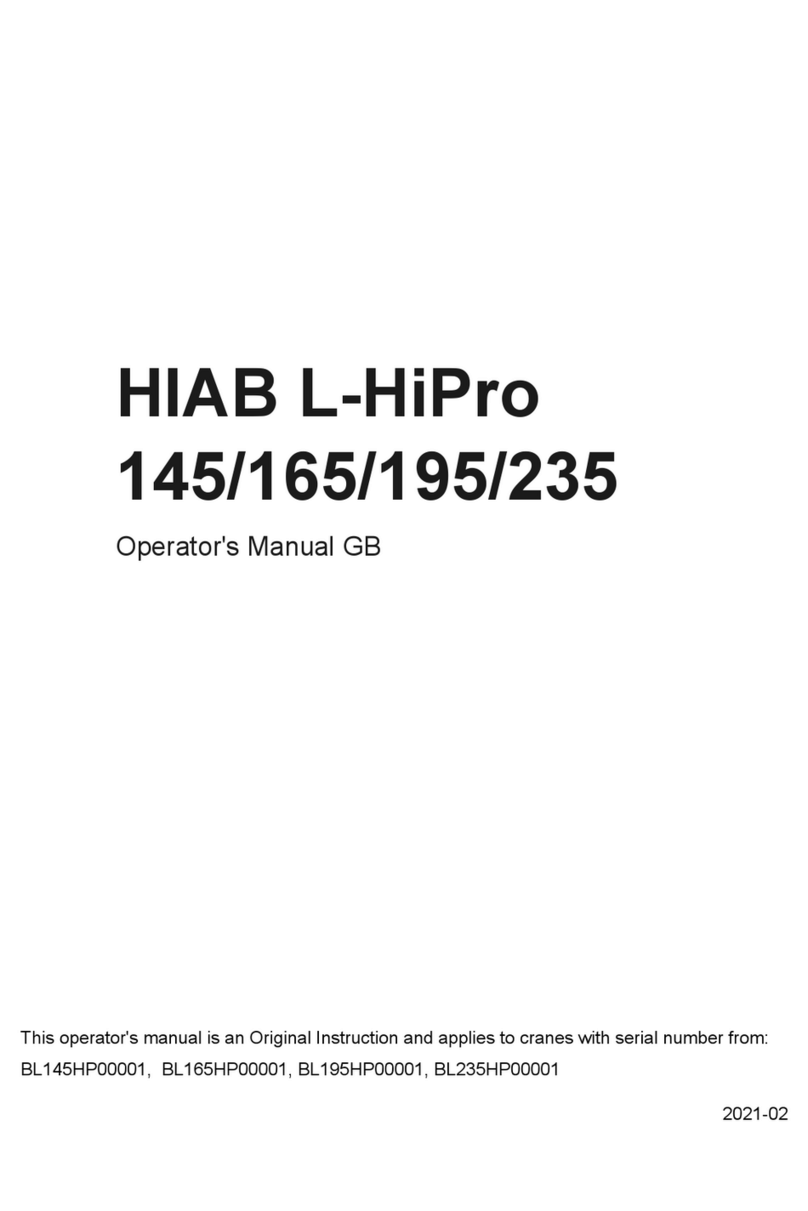
HIAB
HIAB L-HiPro 145 User manual
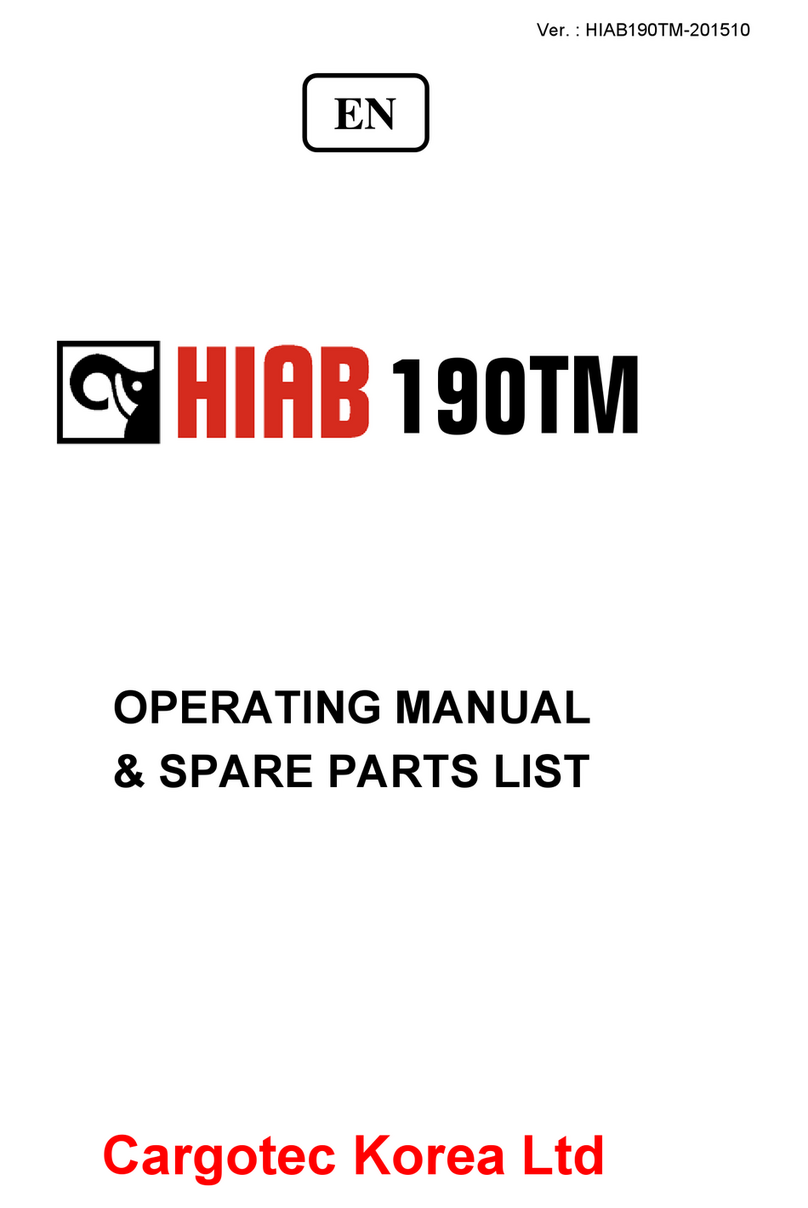
HIAB
HIAB 190TM Guide
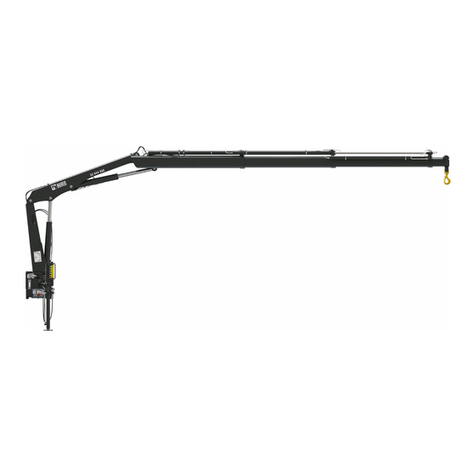
HIAB
HIAB X-Duo 044 User manual
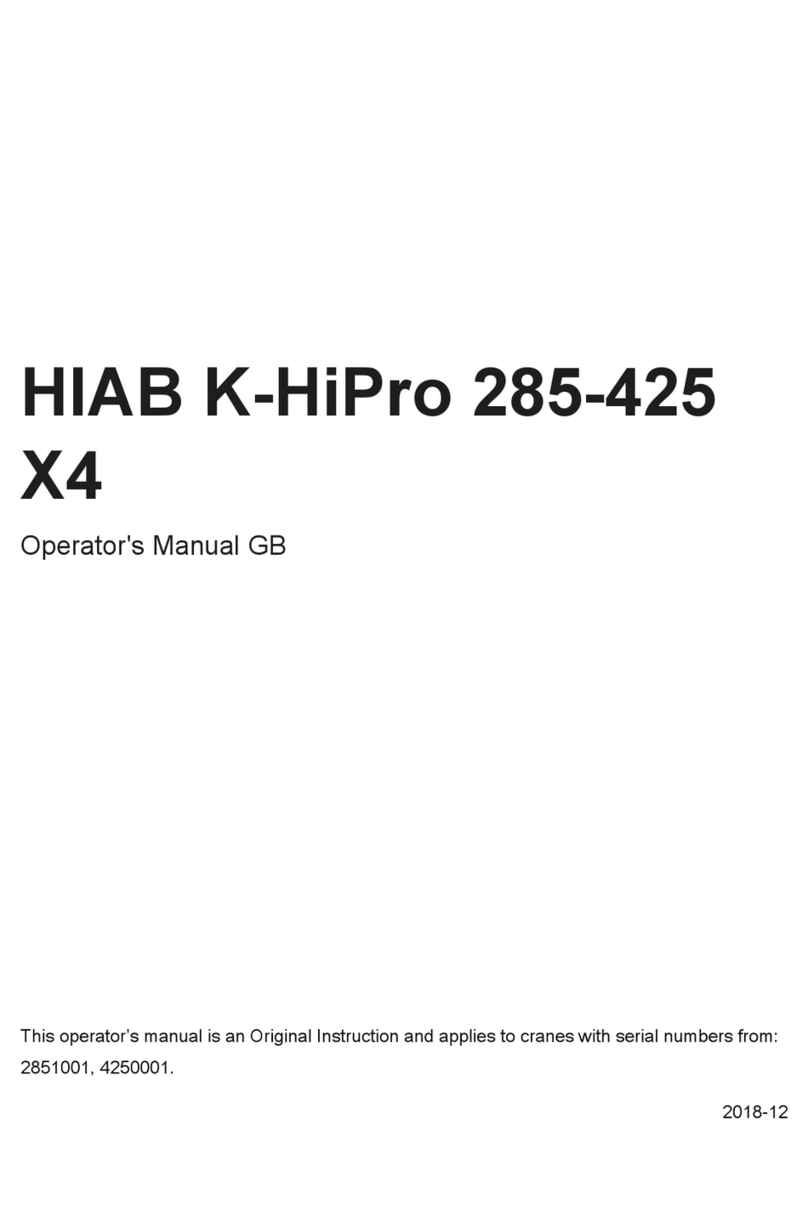
HIAB
HIAB K-HiPro 285-425-4 Series User manual
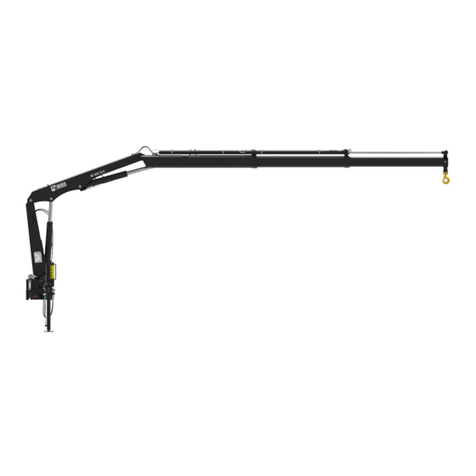
HIAB
HIAB HIAB T-HiDuo 013 CE User manual
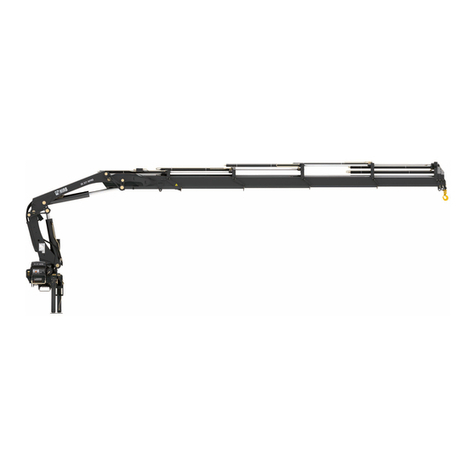
HIAB
HIAB 322 HiPro CD User manual

HIAB
HIAB X-HiPro 142 User manual
